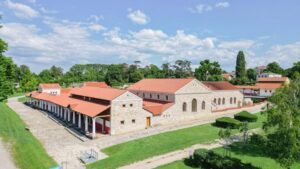In the first century AD Roman Vienna was set up as a military camp right between Michaelerplatz, Graben and Kohlmarkt in the city centre. First and foremost, the camp served as part of the frontier defenses along the Danube. In addition to the camp, the Romans set up an adjacent Roman town in what is today the third district of Landstrasse. At some point, Vienna, aka Vindobona, counted more than 30,000 inhabitants from all parts of the Roman Empire.
To be fair, in the Roman Empire the creation of Vindobona was not breaking news. While Vindobona was just one of many little towns in the Empire the Roman culture shaped its future to a large extent.
What Was Vienna Called By The Romans?

Does Vienna Have Roman Ruins?

Michaelerplatz, Kohlmarkt and Graben. The oldest ruins of Roman Vienna date all the way back to the second to fourth centuries. In the middle of Michaelerplatz, close to the Spanish Riding School Vienna and the Imperial Palace (Hofburg), you can see the bases of Roman houses. The square had been a Roman junction of streets. Kohlmarkt, one of the main Vienna shopping boulevards, was thought to have been one of the main streets that the amber merchants took on their way to the South of Europe. Around the corner of Kohlmarkt, Graben boulevard still takes its name from a Roman ditch there.

Hoher Markt. During extensive canal construction work after World War II, in 1948, canal workers discovered the remains of the tribunal houses of the legionary warehouse Vindobona at Hoher Markt, were the Roman Museum is located. It also became clear that Vindobona had received its supply through an elaborately built 17 km long water pipeline.
Other ways to discover the remains of Roman Vienna is during a wine tasting in a private wine cellar which dates back to Roman times.
By the way, the Roman Ruin at Schönbrunn Palace is an 18th-century folly. The purely decorative architecture was to enhance the palace gardens' aesthetic appeal.
Which Roman Emperor Died In Vienna?

Today the Mark Aurel Strasse close to Hoher Markt which is thought to have been near the Emperor's accommodation, reminds of the Emperor.
What is the Roman Town Near Vienna?

In 106 Carnuntum became the capital of the province of Upper Pannonia / Pannonia Superior. In fact, Roman Emperor Hadrian made Aelium Carnuntum the capital of Pannonia Superior. Here the emperor Marcus Aurelius wrote the second book of his Meditations during his campaign against the Marcomanni (172–174). Its importance is indicated by the fact that Marcus Aurelius resided there for three years (172–175) during the war against the Marcomanni, and wrote part of his Meditations there.
In 193, Roman soldiers proclaimed Septimius Severus, at the time governor of Pannonia, emperor there.
In Roman times, Carnuntum became a major trading centre for amber, brought from the north to traders who sold it in Italy. Most importantly, the main arm of the Amber Road crossed the Danube at Carnuntum. Fortunately for us, the Carnuntum archaeological park brings those times back to life. The site offers visitors a comprehensive look at Roman frontier life, with reconstructed buildings, amphitheaters, and extensive archaeological finds that bring this once-mighty provincial capital back to life. The archaeological museum Carnuntinum, which is situated in the village of Bad Deutsch-Altenburg on the river Danube, exhibits important archeological finds from the ancient city.
Other Roman Traces Around Vienna
Clearly, 400 years of Roman Vienna have left their cultural mark. Our lovely vineyards in the outskirts and our winery culture date back to the Romans. Besides wine, the Romans loved the warm sulphur springs in the Vienna Woods and set up spas there. Even today, locals unearth archeological finds on their very own soil: My brother-in-law's cousin owns a vineyard in the Vienna Woods and has found a couple of Roman coins between his vines in the past.
back to Vienna History
back to Vienna Tourism
back to Vienna Unwrapped homepage






